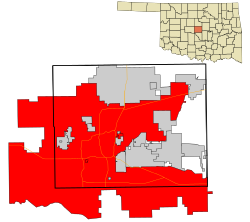
Back Oklahoma City Afrikaans ኦክላሆማ ከተማ Amharic Oklahoma City AN Oclahomaceaster ANG أوكلاهوما سيتي (أوكلاهوما) Arabic اوكلاهوما سيتى ARZ Oklahoma City AST Oklahoma-Siti Azerbaijani اوکلاهوما سیتی AZB Kota Oklahoma BAN
Oklahoma City | |
|---|---|
| Nickname(s): | |
 Location within Oklahoma County, Canadian County, Cleveland County and Pottawatomie County in Oklahoma | |
| Coordinates: 35°28′7″N 97°31′17″W / 35.46861°N 97.52139°W | |
| Country | United States |
| State | Oklahoma |
| Counties | |
| Founded | April 22, 1889[3] |
| Incorporated | July 15, 1890[3] |
| Government | |
| • Type | Council–manager |
| • Mayor | David Holt |
| • City manager | Craig Freeman |
| Area | |
| • City | 620.79 sq mi (1,607.83 km2) |
| • Land | 606.48 sq mi (1,570.77 km2) |
| • Water | 14.31 sq mi (37.06 km2) |
| • Urban | 421.73 sq mi (1,092.3 km2) |
| Elevation | 1,198 ft (365 m) |
| Population (2020) | |
| • City | 681,054 |
| • Rank | 61st in North America 20th in the United States 1st in Oklahoma |
| • Density | 1,122.96/sq mi (433.58/km2) |
| • Urban | 982,276 (US: 46th) |
| • Urban density | 2,329.2/sq mi (899.3/km2) |
| • Metro | 1,441,695 (US: 42nd) |
| Demonyms |
|
| GDP | |
| • MSA | $94.742 billion (2022) |
| Time zone | UTC−6 (Central (CST)) |
| • Summer (DST) | UTC−5 (CDT) |
| ZIP Codes | Zip codes[8] |
| Area code(s) | 405/572 |
| FIPS code | 40-55000 |
| GNIS feature ID | 1102140[5] |
| Website | www |
Oklahoma City (/oʊkləˌhoʊmə -/ ⓘ), officially the City of Oklahoma City, and often shortened to OKC, is the capital and most populous city of the U.S. state of Oklahoma. The county seat of Oklahoma County,[9] it ranks 20th among United States cities in population, and is the 8th largest city in the Southern United States. The population grew following the 2010 census and reached 681,054 in the 2020 census.[10] The Oklahoma City metropolitan area had a population of 1,396,445,[11] and the Oklahoma City–Shawnee Combined Statistical Area had a population of 1,469,124,[11] making it Oklahoma's largest municipality and metropolitan area by population.
Oklahoma City's city limits extend somewhat into Canadian, Cleveland, and Pottawatomie counties, though much of those areas outside the core Oklahoma County area are suburban tracts or protected rural zones (watershed). The city is the eighth-largest in the United States by area including consolidated city-counties; it is the second-largest, after Houston, not including consolidated cities. The city is also the second-largest by area among state capital cities in the United States, after Juneau, Alaska. Along with Topeka, Kansas and Cheyenne, Wyoming, Oklahoma City is one of three state capitals with an indigenous name in a state with an indigenous name.
Oklahoma City has one of the world's largest livestock markets.[12] Oil, natural gas, petroleum products, and related industries are its economy's largest sector. The city is in the middle of an active oil field, and oil derricks dot the capitol grounds. The federal government employs a large number of workers at Tinker Air Force Base and the United States Department of Transportation's Mike Monroney Aeronautical Center (which house offices of the Federal Aviation Administration and the Transportation Department's Enterprise Service Center, respectively).
Oklahoma City is on the I-35 and I-40 corridors, one of the primary travel corridors south into neighboring Texas and New Mexico, north towards Wichita and Kansas City, west to Albuquerque, and east towards Little Rock and Memphis. Located in the state's Frontier Country region, the city's northeast section lies in an ecological region known as the Cross Timbers. The city was founded during the Land Run of 1889 and grew to a population of over 10,000 within hours of its founding. It was the site of the April 19, 1995, bombing of the Alfred P. Murrah Federal Building, in which 168 people died, the deadliest terror attack in U.S. history until the attacks of September 11, 2001, and the deadliest act of domestic terrorism in U.S. history.
Since weather records have been kept beginning in 1890, Oklahoma City has been struck by 14 violent tornadoes, 11 of which were rated F4 or EF4 on the Fujita and Enhanced Fujita scales, and one each rated F5 and EF5.[13]
- ^ Lackmeyer, Steve (December 24, 2019). "Why Oklahoma City as 'The Big Friendly' lacks a friendly embrace". Retrieved August 29, 2023.
- ^ U.S. City Monikers, Tagline Guru website, accessed January 5, 2008
- ^ a b "Oklahoma City". Oklahoma History Society. Archived from the original on April 2, 2016. Retrieved April 12, 2016.
- ^ "ArcGIS REST Services Directory". United States Census Bureau. Retrieved September 20, 2022.
- ^ a b U.S. Geological Survey Geographic Names Information System: Oklahoma City
- ^ "2020 Population and Housing State Data". United States Census Bureau. Retrieved August 22, 2021.
- ^ "Total Gross Domestic Product for Oklahoma City, OK (MSA)". fred.stlouisfed.org.
- ^ "Zip Code Lookup". USPS. Archived from the original on November 4, 2010. Retrieved December 11, 2008.
- ^ "Find a County". National Association of Counties. Archived from the original on May 31, 2011. Retrieved June 7, 2011.
- ^ "U.S. Census Bureau QuickFacts: Oklahoma City city, Oklahoma".
- ^ a b "Metropolitan and Micropolitan Statistical Areas". 2018 Population Estimates. United States Census Bureau, Population Division. April 15, 2019. Retrieved April 18, 2019. [permanent dead link]
- ^ "Stockyards City | Oklahoma City Districts". Visitokc.com.
- ^ "Tornadoes Which Have Occurred in the Oklahoma City, Oklahoma Area Since 1890". National Weather Service Norman Oklahoma. Archived from the original on February 17, 2017. Retrieved December 8, 2015.
© MMXXIII Rich X Search. We shall prevail. All rights reserved. Rich X Search










